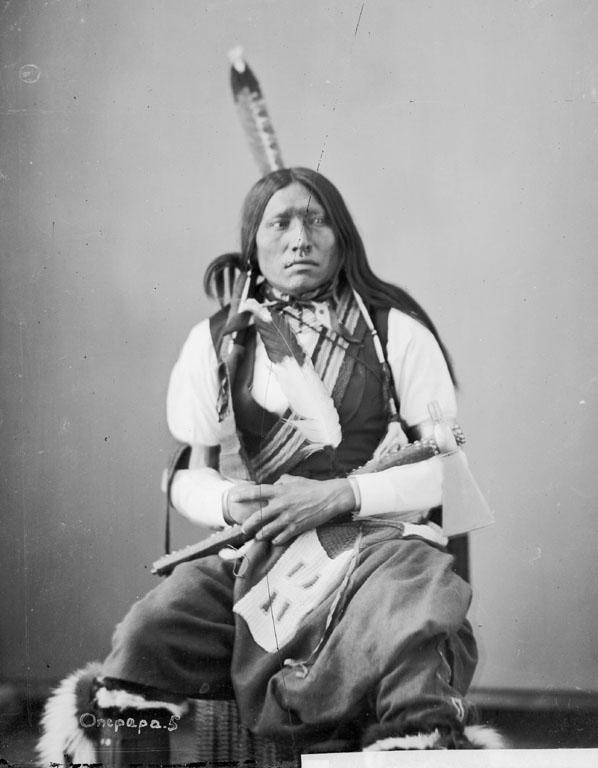
Thunder Hawk, Hunkpapa, 1872, by Alexander Gardner
Cetan
Wakiyan, Chief Thunderhawk
Though little is written about Chief Thunderhawk, it
is known that as a young man he was a campanion of Sitting
Bull, and a warrior of prominence. Since the Hunkpapa
were a small band, Thunderhawk figured was important
in Hunkpapa and Lakota affairs. He was chief of his
band, a position which he retained all his life. His
band followed the buffalo. During the 1870s, Thunderhawk
was dominant leader of the reservation Hunkpapa people
at the Grand River Agency. After allotment, his band
moved to 20 miles below the Agency where his band constituted
28 lodges from Moreau River. He is credited, along with
Mrs. Galpin, with saving the life of Father DeSmet.
He, along with several other Hunkpapa, represented the
Hunkpapa at the Sioux Indian delegation in Washington,
D.C. in October 1888. He is buried near Thunderhawk,
South Dakota south of Morriston, South Dakota.
The
people under his group in 1885:
Okute (Shooter);
Hehaka Najin (Standing Buck Elk);
Sunka Paha Akau Najin (Dog Standing On the
Butte);
Wanbli Upi Luta (Red Eagle Tail);
Hin Waste (Good Fur);
Pehin Siksica (Bad Hair);
Ite Nonpa (Two Face);
Isto Weganan (Broken Arm);
Hitunkasan Luta (Red Weasel);
Kangi Wiyaka (Crow Feather);
Cetan Wakiyan Hunka (Thunder Hawk's Mother);
Hehaka Mani (Walking Buck Elk);
Ihpeyupi (Thrown Away);
Tasunke Hin Luta (His Red Horse);
Wapaha Sapa (Black Hat);
Sungila Luta (Red Fox);
Wanbli Wicasa (Eagle Man);
Ista Zizi (Brown Eyes);
Zintkala Gleska (Spotted Bird);
Sipto Hanpa (Beaded Moccasin);
Okahoniyeiciya (Thrown In);
Oyate (Nation);
Miniata (At the River);
Wahacanka Ska (White Shield);
Hehaka He Maza (Iron Horn Stag);
—
LaDonna Brave Bull Allard

Thunder
Hawk was born in the second half of the 1830s - 1835
according to the date obtained by Dietmar, 1837-38 according
to the 1886 Standing Rock census, which gives Thunder
Hawk's age as 47. He was therefore a younger contemporary
of Sitting Bull's and is mentioned as a boyhood friend
of Sitting Bull in Utley's biography THE LANCE AND THE
SHIELD, p. 10.
Vestal's
SITTING BULL, p. 47, notes Thunder Hawk as one of the
Hunkpapa warriors who counted coup in the battle with
the Crows, June 1859, at Rainy Butte - where Sitting
Bull's father was killed.
Thunder
Hawk enters the documentary record in 1865. Treaty councils
were held at Ft Sully during October of that year. On
October 20 the commissioners met with the representatives
of a tiny camp of less than ten lodges of Hunkpapas.
The camp was located at the junction of Swan Creek and
the Missouri, west of modern Akaska, South Dakota. Its
leaders included three chiefs - Tall Soldier, Little
Bear (father of Tall Soldier), and Iron That Comes Out,
plus a chief soldier Whirling Heart, all of whom attended
the treaty talks. Judging by earlier postings on the
Hunkpapa Bands at the LBH thread, this should be part
of the Che-okhba or Droopy Penis band of Hunkpapas.
This band became the core of the pro-treaty faction
of Hunkpapas.
The
main Hunkpapa village in fall 1865 was on the Little
Missouri, and the diplomacy of trader Charles Galpin
and his Lakota wife (mother Hunkpapa, father Miniconjou:
Broken Arrow band) secured the attendance of sizeable
deputations from the Hunkpapa and several other tribal
divisions. The Galpins brought these paerties in to
Fort Rice and then down the Missouri to Ft Sully. On
October 28 the Hunkpapa contiongent met with the commission,
being represented by the following leaders:
Chiefs:
Gut
Fat
Bear Ribs II (Droopy Penis)
Running Antelope (Sore-Backs)
Heart For All
"Soldiers"
(i.e., akichita or tribal police):
Thunder
Hawk
Iron Horn (Droopy Penis)
Plenty Crows (Droopy Penis)
Fears the Eagle (Droopy Penis)
Spotted Bull
I've added the band name where known.
Thunder
Hawk appears again in the treaty commission reports
from the following year. At Ft Sully the commission
met again the ultra-friendly Hunkpapa camp of Tall Soldier
and Plenty Crows, now counted at 13 lodges. On June
21, 1866 the commission met with 600 lodges at Ft Rice,
including 173 Hunkpapa lodges. The named leaders were
as follows:
chiefs:
Eagle
in the Sky
Left-Hand Bear
Thunder Hawk
Fears the Eagle
Note
that both Thunder Hawk and Fears the Eagle were akcihita
in 1865, rated as chiefs in 1866. Later the commission
met with representatives from the non-treaty village
of Hunkpapas (by difference from the above figures about
150 lodges) - the people of Four Horns, Sitting Bull,
etc. We see here a three-way split in the Hunkpapa tribe,
with a small friendly camp; a modest majority of wait-and-sees
- this includes Thunder Hawk; and a large minority of
non-treaty or 'hostile' people. The four chiefs at Fort
Rice, the fact that two of them had been counted as
akichita the previous fall - make me think
these may be the four Hunkpapa Deciders (Wakichunze)
seated in spring 1866. These were leaders, not necessarily
band chiefs, who were temporarily granted coercive power
to run the big summer hunting villages.
Thunder
Hawk is next mentioned as one of the party that escorted
Fr De Smet to Sitting Bull's village in June 1868 to
secure attendance at the treaty talks at Ft Rice. The
fact that he with Mrs Galpin is credited with helping
save the life of De Smet during the dramatic negotiations
makes me think maybe he's a relative of Mrs Galpin's?
maybe LaDonna can help out on that connection?
Thunder
Hawk is not listed (under that name) as one of the 1868
signatories. He next crops up in the record in a list
of headmen at Grand River Agency in March 1870. He together
with Gall, Wolf Necklace, Heart For All, Slave, and
Little Wound (not to be confused with the Oglala), appear
to have arrived at Grand River from the hunting grounds
in Jan.-Feb. of 1870. He seems to be a fixture at Grand
River/Standing Rock after 1870, accompanying the 1872
delagation to Washington (whence the first phot posted
by Dietmar above). He remained at the agency right through
the Great Sioux War.
Warrior
society affiliations: the skunk skin garters visible
in the 1872 shots are said to be part of the regalia
of the Crow Owners society. The De Smet 1868 connection
suggests that he belonged to the Strong Hearts. Traditionally
isolationist and increasingly militant, the Strong Hearts
formed a core of the emerging non-treaty people. However,
according to Josephine Waggoner one chapter of Strong
Hearts formed around the supporters of De Smet - they
were said to be pro-trader, even pro-Catholic. This
seems to be the origin of the Fool Soldiers who distinguished
themselves in 1862 by rescuing white captives from the
Santees. Thunder Hawk may have been one of their members.
— Kingsley Bray

Some
of the names mentioned in Kingsley's post are pictured
here:
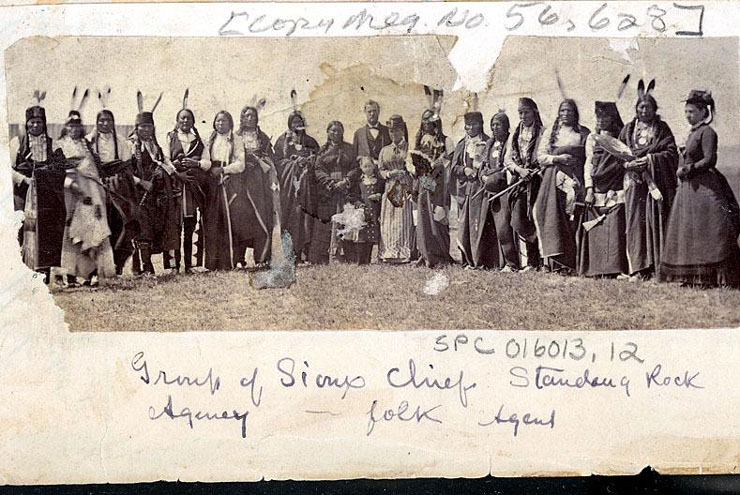
Group of Chiefs at Standing Rock:
third from right: Bear Ribs II
fourth from right: Thunder Hawk
ninth from right: Mrs. Galpin
eighth from left: Running Antelope
second from left: Wolf Necklace
I have seen another version of the photo with the inscription
"Fiske photo - from an old print". So I think
Fiske only copied the original photo of another photographer.
The chiefs look not much older than in some 1872 photos
by Gardner, so possibly it was taken not much later.
John Grass, for example, is shown with long braided
hair. Later in 1880s photos he had his hair cut short.
Look at the Carlisle photo above where he is standing
between Thunder Hawk and Big Head. —
Dietmar Schulte-Möhring

I
heard that descendants of Thunder Hawk are on the Pine
Ridge Res, Porcupine District. I just scanned the 1890
Pine Ridge census and find a Thunder Hawk family in
the Porcupine Dist., belonging to the Waceunpa (Meat
Roaster) band. However the age of this Thunder Hawk,
53, makes him a near-exact contemporary of the Hunkpapa,
not possibly a son. Maybe it's a different family and
coincidence . . . ?
When
did Thunder Hawk and his camp live on the Moreau River?
Just
as an idea, could TH's band be the Legging Tobacco Pouch
band (Hunksa Chantojuha)? They are not mentioned in
early band lists, but appear in the camp-circle obtained
by S.R. Riggs - their place was on the north horn, opposite
the Sore-Backs (Running Antelope's band on the south
horn). Do any of the Thunder Hawk people know what band
he belonged to? — Kingsley
Bray
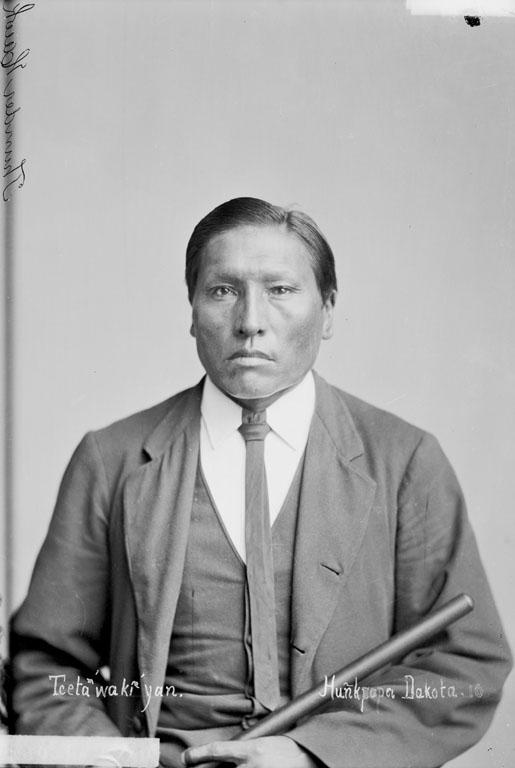
Thunderhawk, Hunkpapa 1888 by Charles Milton Bell
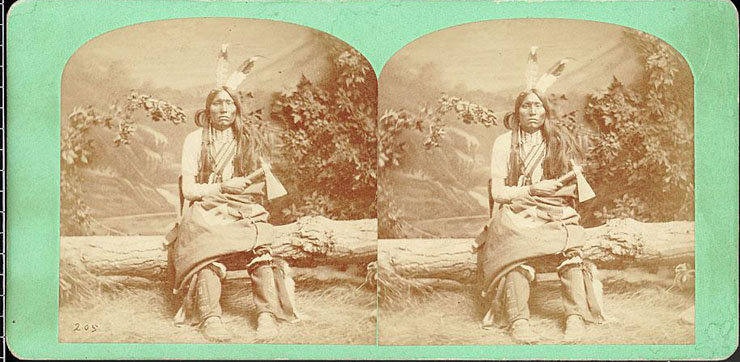
Thunder Hawk by Hamilton & Hoyt, 1872 (?)
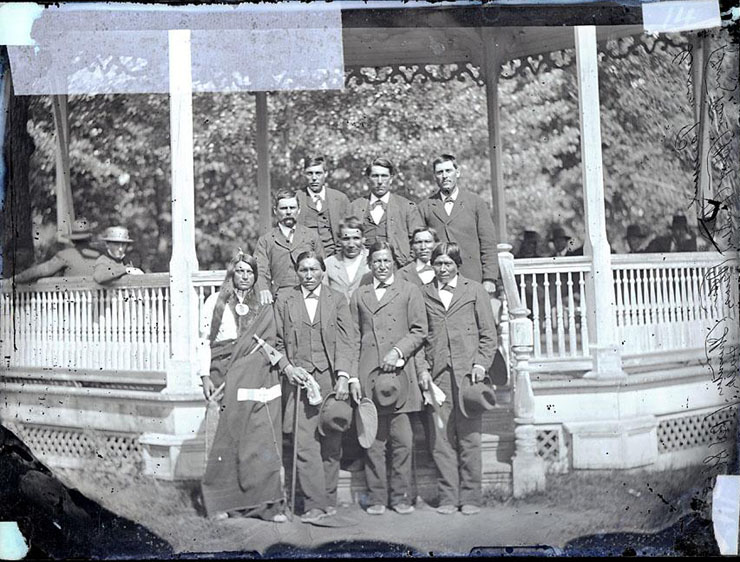
Thunder Hawk, front row second from left. in Carlisle
by John Choate
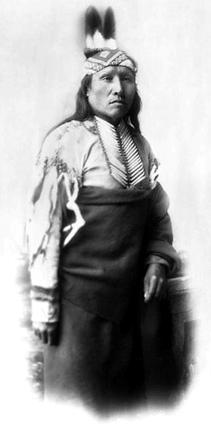
Thunder Hawk by David F. Barry
Obviously
Thunder Hawk´s first delegation trip was in 1872,
when he was photographed by A. Gardner in Washington.
I found somewhere on the internet that he died August
13, 1906, at the age of 71 years.
— Dietmar Schulte-Möhring

I
knew about the Gaplins and Eagle Plume Woman (Mrs Gaplin)
and Father DeSmet. I do believe there is a relationship
with the two. Gaplins daughter were the first teachers
on Standing Rock.
I had the descendance of Thunderhawk come and ask for
back ground and there was not much I could find. I know
that one of the son's ended up in Pine Ridge, One daughter
married a yellow fat and another son married a Looking
Horse.
I wonder if he was one of the chiefs appointed by the
government?
—
LaDonna Brave Bull Allard